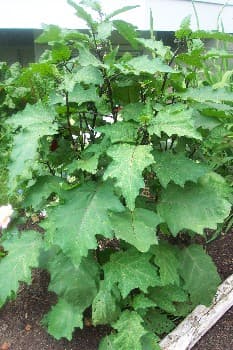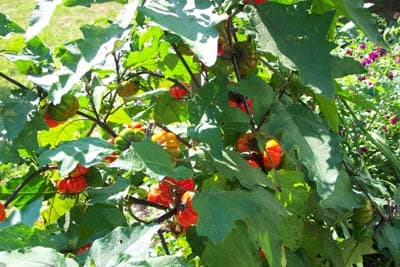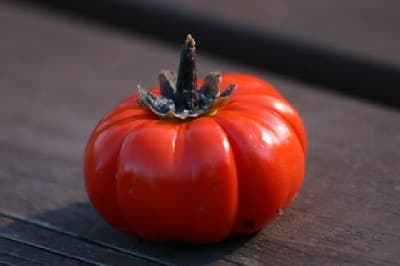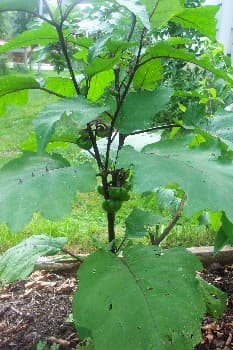How to Grow Pumpkin on a Stick or Ornamental Eggplant

How to Grow Pumpkin on a Stick
Take a good look at this plant. Closely examine the fruit. If you had not seen the name at the top of the page, could you guess what it is? Observing the fruit, most people guess it is a strange variety of pumpkins. That’s why it’s often called “Pumpkin on a Stick” or a “Pumpkin Tree”. Others, speculate that it may be a foreign tomato, lending to the name “Mock Tomato”. Few people guess what botanists call it….. Ornamental Eggplant (Solanum Integrifolium). The plant and fruit looks like no Eggplant that anyone has ever seen….unless you live in Asia, that is. Either way, it is an intriguing plant. So, you just got to learn how to grow pumpkin on a stick. Then, show it off to neighbors and fellow gardeners.
Ornamental Eggplant is a novel plant and is native to Southeast Asia. It will grow quickly to three to four feet tall. Very large leaves grow from a purple, thorny stem. Be careful of the thorns, when working with the plant.
Ornamental Eggplant has an Identity Problem
Does this plant have an identity problem? What do you call it? To most people, it is either “Ornamental Eggplant” or “Pumpkin on a Stick”. But it is called by several other names, too.
Whatever you call this plant (it has many names), it is truly a conversation piece in your garden. We will let you decide whether to place it in the flower garden, or the vegetable garden. Here are some of the many names it has:
- Pumpkin on a Stick
- Pumpkin Tree
- Ornamental Eggplant
- Pumpkin Bush
- Hmong Eggplant – Hmong tribes are found in Laos and Vietnam
- Solanum Integrifolium
- Mock Tomato
- Japanese Golden Eyes
- Chinese Scarlet Eggplant

Uses for Ornamental Eggplant
So, what do you do with this great plant? Here are a few common uses:
Florists remove the leaves and thorns. Then, they let the fruit dry. They use the stem with fruit attached, in floral decorations.
People often as “Is Ornamental Eggplant edible? It certainly is. Asian cultures eat the fruit in Asian stir-fries
Home gardeners show it off as a unique, conversation piece. People are captivated.
Garden Tip: Grow this fascinating plant in a flower garden near your patio or deck or a high-traffic area. Half the fun of this easy-to-grow plant is to watch fascinated visitors and to hear them speculate as to what it is.
Pumpkin on a Stick Plant Propagation
Pumpkin on a Stick is grown from seed. They can be directly seeded into your garden, or seeded indoors for transplanting later. We recommend an early, indoor start. Sow seeds early in the season and cover lightly with 1/4″ or less of fine garden or seed starting soil.
Plants can also be grown from cuttings. However, plants are annuals, and the season may not be long enough to grow new plants from cuttings.
Do not set out seedlings until after the last frost date in your area. Plants are susceptible to frost.

How to Grow Ornamental Eggplant
Ornamental Eggplant is easy to grow. It likes full sun but will tolerate partial shade. Plants grow three to four feet, with huge leaves. Give this plant plenty of room to grow. The ideal plant spacing is three feet apart.
The soil should be rich and drain well. Mix compost into the soil, before planting.
These plants like a lot of water and nutrients. While they like lots of water, they do not like wet soil. Keep soil moist, not wet. Add fertilizer when planting, and every month during the season.
Early in the season, add mulch around the plants to keep the weeds down.
Small flowers will begin to develop from the main stem in mid-summer. Three to four flowers will form in a cluster, followed by small green fruit. The Eggplant ripens to a deep, red-orange color.
Plants can grow 3-4 feet tall. They will likely require staking, as the fruit develops. Otherwise, the weight of many growing fruit on the stems will cause the plant to droop, and stems may break.
Plants are annuals that are susceptible to frost. Cover them up whenever cold temperatures are expected.
Caution: Be careful when first working with this plant. It has many long, sharp thorns on both the stems and the leaves.

Insects, Pests and Plant Disease
A variety of insects may eat the leaves of the plant. Treat with insecticide or repellents, as needed.
Deer, bunnies, and other foraging animals leave the plant alone. They do not like the plant’s thorns.
Fungus diseases can occur. Use a general-purpose fungicide in humid weather, and when problems appear.
Related Articles
People who read this article on purslane plants also liked:
Pumpkin on a Stick – from the experts at Pumpkin Nook
Please support our site. Shop for:
- rmmatthews100@hotmail.com
- 585-721-6528
- Rochester, NY
©1999-2024 GardenersNet.Com, All Rights Reserved

